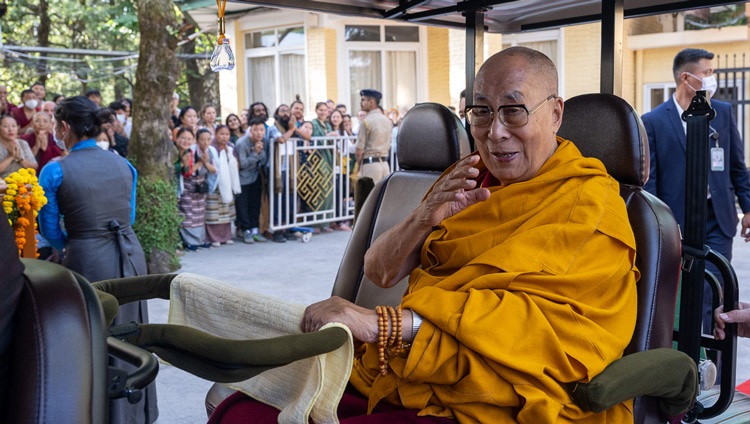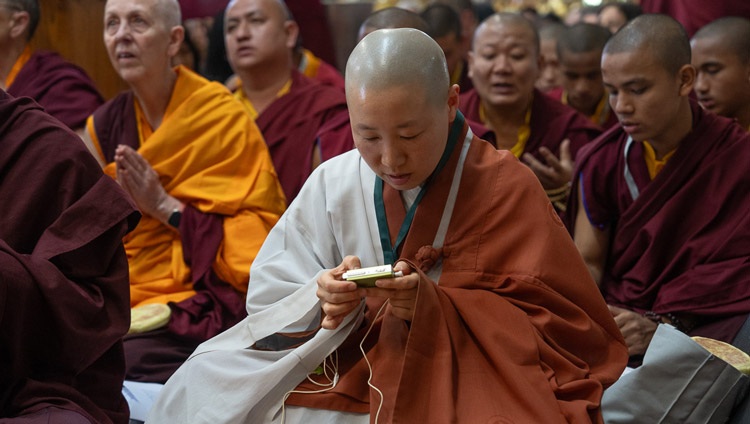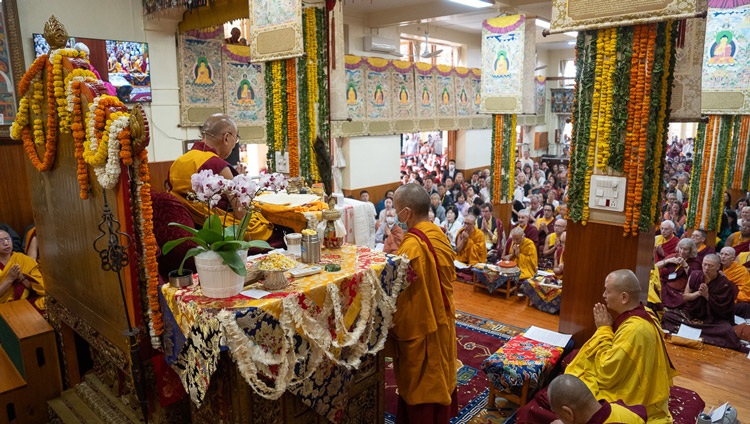Thekchen Chöling, Dharamsala, HP, India - An estimated 8500 people gathered in the Tsuglagkhang, the Main Tibetan Temple, and the surrounding courtyard this morning. The weather was warm as His Holiness the Dalai Lama drove to the temple steps. He smiled and waved to well-wishers who greeted him as he passed.

Once he was seated on the throne, His Holiness spent a few minutes performing the preliminary procedures for the Mahakala permission he was going to give. When he was ready, the first thing he had to say was that his mother used to speak of “Our Mahakala, our protector,” because she felt so close to him.
“When I was about to leave the Norbulingka Palace,” he continued, “I went to the Mahakala chapel and told him I was going to go into exile in India. I made a prayer before him and felt that he nodded, indicating that the issue of Tibet would eventually be settled. I feel Six-armed Mahakala is unique and since we came into exile, his enlightened activities have been continuously supportive.
“Today I’m going to give the permission for the combined practice of four deities in relation to Six-armed Mahakala. There are monastics and lay-people here who place their trust in Mahakala and there are other people whose interest in Buddhism and the name Dalai Lama is new. The Dalai Lama is the one who makes known the activities of Six-armed Mahakala and he serves me too.
His Holiness recited the first verse of a praise to Six-armed Mahakala:
Wearing anklets, your feet trample Vinayaka.
Mahakala, you wear a tiger skin skirt.
Your six arms are adorned with ornaments of snakes.
Your [upper] right hand holds a curved knife, your middle [hand] holds a garland,
Your lower [hand] fiercely plays a hand drum.
Kalu Rinpoché, who requested today’s permission, offered an extremely ornate mandala, as well as representations of the body, speech and mind of enlightenment.

His Holiness repeated that he had felt close to Mahakala since he was a small child and that Mahakala had taken special care of him. He remarked that while he considers cultivating the awakening mind of bodhichitta and the wisdom understanding emptiness to be his main practice, he feels these practices are at the heart of Mahakala too.
“Even when I went to China and since coming into exile here in India I have relied inseparably on Mahakala. Those of us in exile are free and so we pray to Mahakala. All this time he has been my main Dharma Protector.
“Kalu Rinpoché has a unique connection to Six-armed Mahakala and his students have expressed a wish to receive this permission. I feel that there is something different about Six-armed Mahakala. He helps us accomplish common siddhis and realize bodhichitta and emptiness.
“There is a story about the Mahasiddha Shavaripa. Mahakala appeared to him when he was meditating in the Cool Grove charnel ground. Mahakala taught him how the four deities could be practised in combination. The revered Vajrayogini, Avalokiteshvara and Tara also appeared to him and gave him instructions about their respective practices.
“Shavaripa compiled a method for practising the four deities together. He passed this on to Maitripa, who in turn passed it on to Khyungpo Naljor, founder of the Shangpa Kagyu Tradition of Tibetan Buddhism.

“The Mahasiddha Rahula had a vision of the four deities immediately after he was born. His biography records that he saw Mahakala, Lokeshvara, Vajrayogini and Tara. In due course, Khyungpo Naljor also received teachings from Rahula.
“It is said that Khyungpo Naljor achieved realization by meditating on this practice consistently for three months without distraction, doing one session before dawn each day. He is said to have achieved both common and supreme realizations. This reference indicates that the fruits of this practice are quickly accomplished.”
His Holiness described how to visualize Vajradhara surrounded by Mahakala, Vajrayogini, Avalokiteshvara and Tara in preparation for taking the Bodhisattva vows.
He noted that he had received the thirteen permissions related to Mahakala from Tagdrag Rinpoché, as well as the blessings of Mahakala from Kyabjé Ling Rinpoché.
“I meditate on bodhichitta every day from the moment I wake up and I observe the Bodhisattva precepts. To achieve our own goals and the welfare of others, we need bodhichitta. To fulfil our short term and long term aims, we need bodhichitta. To accumulate merit and wisdom, we need bodhichitta.
“Having cultivated bodhichitta, the purpose of which is to serve all sentient beings, we are determined to achieve Buddhahood for all of them, whether we know them or not. We consider all sentient beings as near and dear to us. This supreme conduct of a Bodhisattva is why cultivating bodhichitta is so important.”

Next, His Holiness gave the uncommon vows of tantra. As part of giving the permission, he once again described how to visualize the deities and gave transmission of the respective mantras.
Lama Vajradhara—Namo Buddha ya / Namo Guru Hya/ Vajra Vira Virena Shriye / Daka Dakini / Jvaki Jvakini / Sarva Buddhaya / Bodhisattva Sharanam Gacchami Kyai Kyai
Mahakala—Om Vajra Mahakala Kshim Kshetra Vighan Vinaya Tra Hum Hum Phat Phat Svaha
Revered Vajrayogini—Om Vajra Nara Trim Trim Hung Hung Phet Phet Svaha
Avalokiteshvara—Om Vajra Raksha (Namah) Samanta Hum Phet
Arya Tara—Om Tare Tuttare Ture Svaha
Kalu Rinpoché offered a thanksgiving mandala and the three representations of enlightenment. Meanwhile, as a feast offering was made, a procession of offerings, including a rich array of sacred images, was carried through the temple.

Next was recited the ‘Song of Immortality, a Prayer for the Long Life of His Holiness the Dalai Lama’ composed by his two tutors Kyabjé Trijang Rinpoché and Kyabjé Ling Rinpoché. The following four lines consist of the song’s refrain:
To you we make requests with intense longing
Grant inspiration that Tenzin Gyatso, Lord of the Land of Snows,
May live for a hundred aeons, unperishing
And may his aims be achieved of themselves.
This was followed by a recitation of the ‘Melody of the Nectar of Immortality’, a prayer for His Holiness’s long life written by Jamyang Khyentsé Chökyi Lodro.
His Holiness announced that to bring the session to an auspicious conclusion he would give the transmission of ‘A Praise to the Six-Armed Mahakala’ composed by Mahasiddha Shavaripa when he had a vision of Mahakala.
“I recite this every day,” His Holiness revealed. “And I advise those of you who admire me, to recite it too, wishing that you may be successful in this and future lives.”












